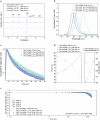Ultrapure and efficient electroluminescence in alkali metal doped inorganic perovskite quantum wires arrays
- PMID: 40595585
- PMCID: PMC12216398
- DOI: 10.1038/s41467-025-61085-6
Ultrapure and efficient electroluminescence in alkali metal doped inorganic perovskite quantum wires arrays
Abstract
Alkali metal doping has been widely utilized to regulate metal halide perovskites and improve their luminescence performance. However, due to the discordant tolerance factor caused by the smaller size of potassium and rubidium ions, it is still debatable whether they can be incorporated in the cesium perovskite crystal lattice. Here we provide unambiguous evidence for the formation of Rb+ and K+ substitutionally doped stable perovskite cubic crystal structure in the form of quantum wires embedded in nanoporous alumina template. The suppressed inner defects and enhanced exciton binding energy lead to a reduced non-radiative recombination in the co-doped perovskite quantum wires. The perovskite light-emitting diodes with a maximum external quantum efficiency of 17.5%, 21.2%, 24.9% and 30.1% and a maximum luminance of 1638 cd m-2, 3365 cd m-2, 13,483 cd m-2 and 31,706 cd m-2 for electroluminescence peak of 476 nm (primary-blue), 483 nm (sky-blue), 490 nm (sky-blue) and 512 nm (green) are fabricated respectively. Surprisingly, all devices emit high-color purity light with narrow linewidth of ≤16 nm.
© 2025. The Author(s).
Conflict of interest statement
Competing interests: The authors declare no competing interests.
Figures




Similar articles
-
Optimizing Perovskite Surfaces to Enhance Post-Treatment for Efficient Blue Mixed-Halide Perovskite Light-emitting Diodes.Adv Mater. 2025 Jun;37(25):e2414788. doi: 10.1002/adma.202414788. Epub 2024 Dec 4. Adv Mater. 2025. PMID: 39632461 Free PMC article.
-
Use of CsPbCl3 Quantum Dots as a Chlorine Source Enables Formation of Thick Quasi-2D Perovskite Films for High-Performance Blue Light Emitting Diodes.Adv Mater. 2025 Jul 1:e2506970. doi: 10.1002/adma.202506970. Online ahead of print. Adv Mater. 2025. PMID: 40589330
-
Augmentation of Pure-Blue Electroluminescence in Quasi-2D Perovskite Light-Emitting Diodes Using a Multifunctional Additive of 4-Aminobenzophenone.ACS Appl Mater Interfaces. 2025 Aug 6;17(31):44728-44737. doi: 10.1021/acsami.5c10043. Epub 2025 Jul 22. ACS Appl Mater Interfaces. 2025. PMID: 40696720
-
Progress on solid-state synthesis and photoluminescence applications of all-inorganic metal halide perovskite nanocrystals.Nanotechnology. 2025 Sep 9;36(37). doi: 10.1088/1361-6528/adfd64. Nanotechnology. 2025. PMID: 40834871 Review.
-
Strategies for Controlling Emission Anisotropy in Lead Halide Perovskite Emitters for LED Outcoupling Enhancement.Adv Mater. 2025 Jun;37(25):e2413622. doi: 10.1002/adma.202413622. Epub 2024 Dec 15. Adv Mater. 2025. PMID: 39676496 Free PMC article. Review.
References
-
- Saliba, M. et al. Incorporation of rubidium cations into perovskite solar cells improves photovoltaic performance. Science354, 206–209 (2016). - PubMed
-
- Abdi-Jalebi, M. et al. Maximizing and stabilizing luminescence from halide perovskites with potassium passivation. Nature555, 497–501 (2018). - PubMed
-
- Kausar, A. et al. Advent of alkali metal doping: a roadmap for the evolution of perovskite solar cells. Chem. Soc. Rev.50, 2696–2736 (2021). - PubMed
-
- Li, Y. -h. et al. Review on the promising roles of alkali metals toward highly efficient perovskite light-emitting diodes. J. Mater. Chem. C.11, 2011–2025 (2023).
-
- Wang, Z. et al. Suppressed phase segregation for triple-junction perovskite solar cells. Nature618, 74–79 (2023). - PubMed
LinkOut - more resources
Full Text Sources

